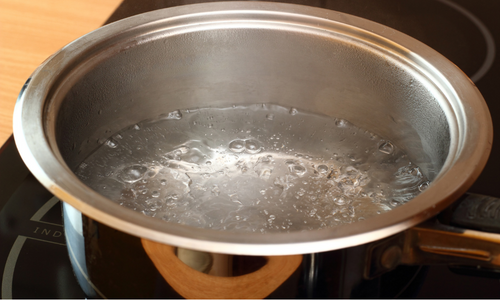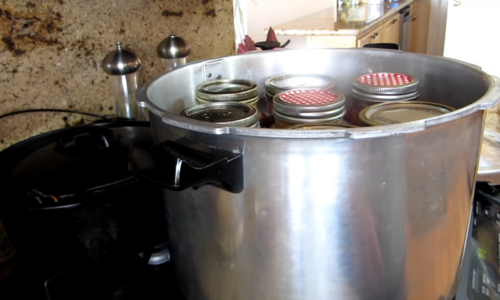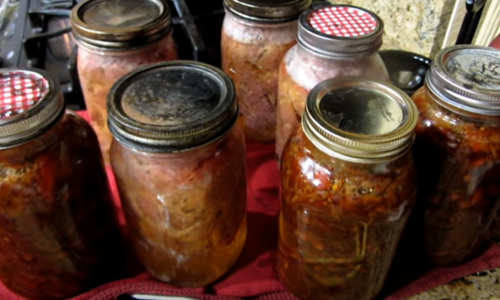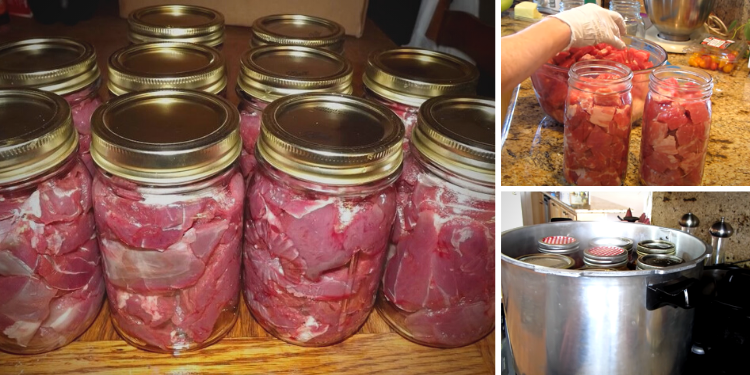When I first heard of pickling meat, I didn’t know what to think. In my mind, I pictured kosher dill pickles and really wondered if the meat would taste like that. However, it was when I had a further understanding of food preservation that I truly began to realize what pickling is.
Pickling is the act of preservation through the use of an antimicrobial liquid that is often made with salt. Some examples of pickled beef are things like pickled sausage.
By learning to preserve meat through pickling, you are one step closer to food preservation. Here we will discuss pickling meat and how to store it to have the best shelf life possible.
As a kid, I used to see jars filled with pickled pigs’ feet and sausages often. Now, I never ate them until I was an adult.
How Long Does Pickled Beef Last?
Pickled beef can last up to 5 years if canned and stored correctly. For this recipe, you will need quarter jars, a pressure canner, one cup of salt, beef, and 4 cups of water.
The best option if you want to add this meat to your stockpile is to can it in a pressure canner by following your manufactures instructions.
When preserving meat, you should always take safety as your number one priority.
⇒ Click Here To Learn How To Can Hamburger Meat For Long Term Preservation
Never water bath meat because it will not kill all the bacteria and leave you at risk; pressure canning is crucial.
Directions:
In my large pot, I brought water to a boil and added salt and some pepper.
I placed the cut beef meat inside the jars. Make sure you leave enough head space and also take all the air pockets out.

Add a little bit of the brine to the jars. This heats up the jars and makes your meat juicier. Fill it up about two inches. The salt in the brine also helps inhibit the growth of harmful bacteria. If when you open your jars you notice any mold on top, something is not right.
Take a very clean rag and dip it into a little bit of clean water and clean the rims of the jars. Do this to make sure there are no food particles that would cause a failure in the seal. Then, with a dry part of the rag, dry off the rims.
Related: 7 Deadly Canning Mistakes Even Smart People Make
Next, put brand new lids on the jars and tighten them down with your band. For pressure canning you need to make sure the lids you are using are new.
Then, put your jars in the pressure canner. Make sure you have a rack on the bottom of your canner, so the jars don’t bounce and break. Each pressure canner is a little bit different, so make sure you read the directions on your pressure canner.
Once the pressure canner has come down to a zero pressure, you can take your jars out. 
Ways To Use Pickled Beef
I like cooking my meat and using it for tacos. I found that by using this meat in tacos, I was able to really enjoy the salty flavor. I seasoned the meat when frying it with some basic taco mix and it really did do wonders.
You can also add this meat to stews, salads and sandwiches or you can dehydrate it. I really believe pickle beef would make a wonderful addition to any meal where you would either traditionally use lunch meat or even need something salty.
How Long Does Pickled Beef Last?
If the pickled beef is pressure canned correctly, it can be used up to 5 years later. Any leftovers should, however, be stored in the fridge and consumed within the next three days.
The shelf life of most canned goods is arguable because of the fact that it is really based on your process, storage, and many other factors. By learning to pickle meat, you are just one step closer to a more sustainable future and producing all your own foods and flavors.
Having the knowledge and skill to preserve food is critical in any situation, including times of great need. Our ancestors who lived during the Great Depression learned fast to be able to fend for themselves.






















what are the amounts of ingredients used to process the beef? this is a good fyi article and would like to see more like it
my apologies, i read the article before my coffee. i saw the amounts after i reread it. it gets worse the older i get
I think this recipe is more properly defined as “canned beef”. Pickling is a fermentation process. I’ve done this recipe many times with venison. The outcome is delicious, tender and very versatile.
I pressure can my meat, have done it for years. I stuff the meat in add salt and pressure can it for the time and pounds required for my area. I have opened jars that are over 5 years and still good. I make my own Spam and have many jars that are still good.
Good article, but it isn’t pickled beef!!
Kay, I would like to talk to you more about making Spam. When you have time, where did you find the recipe for making it or how do you make it?
I, too, would like to know more about making Spam, please.
Kay: Do you have a recipe for your spam? Yum!
I found this article on How to make spam
That was my thought too. I can beef, venison, pork & chicken this way.
You can google the recipe. There are several. I made a lot of it last year and used different recipes. It does taste a lot better homemade!
I would like to know the amount of salt and secondly, how far the jar is filled with the brine.
Fill within 1 in of top an 1/ 2 teaspoon of salt per pint/ 1 teaspoon per qyurt
Is only 2 inches of brine put in the jars?
one thing that seems to not be mentioned in all the canning articles is the storage aspect. Ive canned for years along with my mother who raised 3 kinds on canned foods. Storage can not be overlooked! Even if one has done the proper sterilization, canning methods etc, one has to have good cool temperatures to store the canned product. One can not expect to have canned goods keep for any real length of time if it is kept at a high temperature, it will continue to “cook” and go bad in the jar. One has to have a storage area where it can be kept at about 75 degrees or so. I was painfully reminded of this when one year I put down 24 pints of mango jam. Where I kept it got warm like 80 degrees, it all turned brown and went bad.
I keep mine in my canning room. It is usually 77-82 degrees. I have never had a problem. I make mango jam every year.
… Just for the record … meats have been preserved by water bath method for hundreds of years all over the world, including in the US … but the key is knowing what you are doing and having the confidence in your skills … the people that do this method have learned it from their parents and grandparents … and have lived to do it this way themselves … Personally, I would not have the confidence in my skills to do a water bath method on meats and many other types of foods … BUT JUST BECAUSE YOU DON’T HAVE THE SKLLS DOESN’T MEAN IT ISN’T SAFE … ! … you can refer to the FDA’s standards as a preferred guideline , but please stop spreading misinformation …
The only thing I’ve tried is salt fermenting garlic. It is easy and soooooooo good.
Can you do the pressure cooker method without jars and vacuum seal for storage?
No, Vacume sealers are great, I use mine constantly, but on foods that require pressure canning such as low acidic foods do not risk your safety by vacume sealing unless your going to freeze them.
Joel, I vacuum seal a lot of food, both cooked and raw, and I always freeze it right after I seal it. It has always turned out great. Fresh produce and discounted meat bargains, a food saver is a great tool to have to store food.
BTW, I don’t have much concern over power outages thanks to generac running on natural gas. So my freezer keeps on freezing.
No so don’t try it. Unless you freeze it, it will go bad fast!
I have been bottling meat for years but not pickling. I am not understanding the difference between what you are talking about a what I do. I put uncooked meat (beef, pork, chicken, etc –I do brown groound beef not other things) in my jar–I add 1 tsp kosher salt per quart, fill with boiling water and pressure. You seem to be using less salt than I do (did I read that right?). Uusually I think of pickling as adding salt and vinegar. Am I on the wrong track?
I find my bottled meats/poultry is good for almost anything I want to use it for.
Thanks for the info–
Rachael
I’m sure you all know this but I just discovered that Ball sells a fermentation kit. It is $9.00 in my area but very handy if you do limited quantities like me.
For o;d-school pickled meat (at least as I was taught) Make sauerkraut, when nearly done, pack meat in the bottom of a crock, add a layer of kraut, more meat, more kraut. Cover with good water, and press down with clean weights. It should be cured in 3 days to a week. This is for cured meat. It’s still raw, and it and the kraut have to be cooked. It’s a great sauerbraten or traditional cured pork. We do this with summer kraut, no salt, and it’s even better. A major plus, meat and kraut can be frozen and remain good for up to a year. If using salt (winter kraut) no more than 3 months is recommended. niio
I have so many questions and would love to learn from you. At which point does the meat have to be cooked with the sauerkraut method? And you cannot just put this in jars after and store it? It has to be frozen after? Just want to know the benefits and best way to store and if I can store without freezing. Thank you!
This may sound stupid but, is the meat COOKED by the pressure canning process or is it considered raw and still in need of cooking? In the photos the meat
still looks raw in the jar.
Since the time for pressure canning is somewhere between an hour or 90 minutes at pressure, technically the meat is cooked, but it is better to cook it once opened to kill any possible bacteriea. I never saw any jars of meat that didn’t look cooked so considered those raw. My aunt canned entire moose and occasional cows and pigs. She used a different method, by brining the chunks of meat to a boil in salted water, then packing her hot sterilized jars with hot meat, and adding the hot brine it was boiled in, you might get fewer jars but pre heating the meat shrinks it and you get more meat per jar a consideration when you have fewer jars and live miles from a store. It also gives you brine a better flavour.
If you pressure can per recomendations, the meat is well cooked and tender, even tougher cuts. Pressure canning/cooking puts a whammy on it.
Milton Wiseman,
The natural gas makes it to your house by way of pumping
stations which are powered by electricity.
For everyday reliability to power a generator propane is the best
choice then gas or diesel.IMHO.
It is my understanding that a freezer needs about four hours of
power per day to keep food frozen.
Some of the solar generators will work on larger appliances such as a freezer.So they say,It might take some research.
A back up gas generator will give peace of mind.
I read recently that Obama just had something crazy like 50,000 gallons of propane delivered to his home, Hmmm I wonder what he knows?
I have been growing and preserving my own food since I was 18 y/o so 50 years’ experience. I will tell you to use the original accurate terminology for canning, whether pressure canning or water bath canning. You suggest it is better to use a quarter jar ???there are not quarter jars– in the picture I saw a Pint canning jar, do not make up a different name, it will confuse people who are not experienced with food preservation. Using pint canning jar’s is no safer than using Quarts, What determines safety is the very clean technique used and getting a good home Canning and Preservation Book and following the directions to the word. When you say always use a new canning lid for pressure canning, you are correct, but really always say for all canning, pressure and water bath use new lids. You pack your jars with the food 1st leaving — 2 in. of head space, then slowly pour your hot liquid in, leaving 1 in. head space no less. This recipe is not true pickling at all . Canning a food item with using plain hot water is as good or better than any of the other concoctions people come up with. I have pressure canned Chicken with out and with the bones, chunked Beef, chunked Pork, Hamburg, Fish, it all is wonderfully tender and a great flavor, but the best part is the wonderful stock from the meat, great for gravy , soups, sauces. With Pressure Canning pay close attention to the required Pounds Pressure and amount of time needed to process. My meats have lasted past 5 yr.’s easily and are as good as newly processed, but technique is everything.
I saw Amish do this when we were looking at houses in their area. TBH it looked kinda gross, and rawish. I’d rather freeze-dry my meat, but canning them will be better after electricity goes in SHTF.
How much meat is used, any differences on the type of meat used? I like to follow a recipe exactly like the recipe calls for. About how many pints are use?
You should look at the homestead accounts on youtube. There are a lot of people walking you through canning meats such as Homesteading Family – Canning Raw Chicken video. Also, Living Traditions Homestead, Offgrid with Doug and Stacey, lots of great homestead preppers. IIRC, a pound of ground beef fills a pint jar. Anyway, this website here is mostly good for initial ideas of what you should be thinking about, but very lacking in accurate details. Most of the best info is in the comments!
When I pressure can meet which I have been doing for 50 years, I sear the Beef or Venison. Rule of Thumb—cold jar, cold meat and cold canner with cold water. If you’re going to use hot meat, you need hot jars and a hot Water in hot canner. .Cut it into strips to make tenders, chunks for stews and soups, hamburger for tacos. I put the meat in a sterilized jar. Rule of thumb-cold jar, cold meat, and cold water in cold canner. If you’re going to use hot meat, you need hot jars and a hot water in a hot canner. I always just add water, salt is always optional. However I have usually seasoned my meat before I can it, so there is no need to add additional salt. For chicken I just put it in a jar/pint/quart and add chicken broth. Some people say the chicken makes its own broth but in my experience this is not the case.